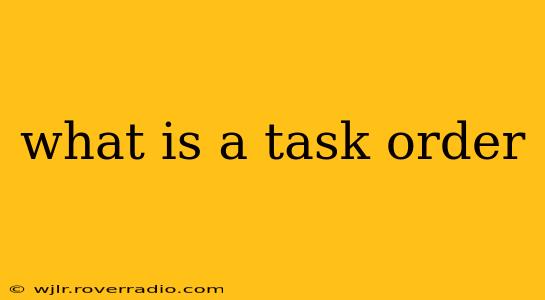What is a Task Order?
A task order is a type of contract used primarily by government agencies and large organizations to procure goods and services. It's a streamlined way to purchase items or services already defined under a larger, overarching contract known as a master contract or blanket purchase agreement (BPA). Instead of negotiating a separate contract for each individual purchase, agencies use task orders to quickly and efficiently acquire needed items or services within the established parameters of the master contract. Think of it like having a pre-approved shopping list and simply ordering items from that list as needed.
This approach offers several key advantages:
-
Efficiency and Speed: The procurement process is significantly faster because many of the details (pricing, terms, and conditions) are already pre-negotiated in the master contract. This reduces paperwork, delays, and overall administrative costs.
-
Cost Savings: Negotiating a master contract with multiple potential task orders often leads to better pricing than negotiating individual contracts each time. This is due to economies of scale and the reduced administrative overhead.
-
Reduced Risk: The terms and conditions are already established, minimizing potential disputes and streamlining the contract management process.
What are the key components of a task order?
A task order typically includes:
- Reference to the Master Contract: Clearly identifies the master contract under which the task order is issued.
- Specific Services or Goods: Details the exact goods or services required, quantifying them clearly to avoid ambiguity.
- Delivery Schedule: Specifies the timeline for completion or delivery.
- Price: The cost of the task order, often determined by pre-negotiated pricing schedules or rates in the master contract.
- Payment Terms: Outlines the process for payment to the vendor.
How does a task order differ from a traditional contract?
Unlike a traditional contract, which requires extensive negotiation for each purchase, a task order leverages the pre-negotiated terms and conditions of a master contract. This eliminates redundant negotiations and simplifies the procurement process considerably. Think of it as ordering from a menu versus negotiating the ingredients and price of each dish individually.
What are some common uses of task orders?
Task orders are frequently used for a broad range of services and goods, including:
- IT Services: Software development, system maintenance, cybersecurity services.
- Construction and Maintenance: Repair work, renovations, infrastructure projects.
- Consulting Services: Specialized expertise in areas like finance, legal, or management.
- Training and Education: Workshops, courses, and professional development programs.
What are the benefits of using task orders?
The benefits extend beyond the contractor/vendor:
- For the Agency: Improved efficiency, cost savings, reduced administrative burden, and less risk.
- For the Contractor: Reduced bidding costs, stable workload (potentially), and quicker payment cycles.
How is a task order awarded?
Task orders are typically awarded through a competitive bidding process outlined in the master contract. However, the process is often streamlined compared to a full contract negotiation because many aspects are already pre-defined.
What are some common pitfalls to avoid when using task orders?
While task orders offer numerous advantages, potential issues can arise if not managed properly:
- Scope Creep: The tendency for the scope of work to expand beyond the initial specifications in the task order, leading to disputes and cost overruns.
- Poor Communication: Lack of clear communication between the agency and the contractor can lead to misunderstandings and delays.
- Inadequate Planning: Failure to properly plan and define the requirements of the task order can lead to inefficiencies and cost overruns.
By carefully planning, communicating clearly, and closely managing the task order process, organizations can leverage the significant benefits of this streamlined procurement method.
